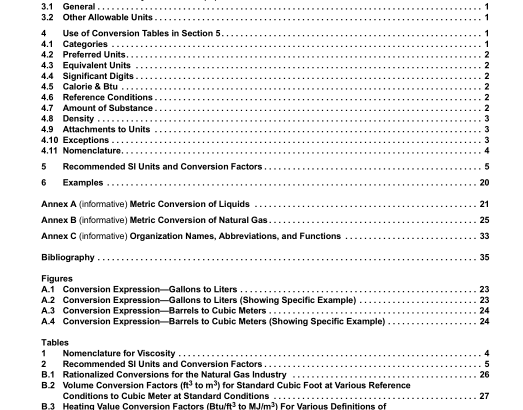API MPMS 15:2019 pdf free download.Manual of Petroleum Measurement Standards Chapter 15 Guidelines for the Use of Petroleum Industry- specific International System (SI) Units
This publication specifies the API-preferred units for quantities involved in petroleum industry measurements, and indicates factors for conversion of quantities expressed in customary units to the API-preferred SI units not covered in ASTM/IEEE SI-10. The quantities that comprise the tables are grouped into convenient categories related to their use. They were chosen to meet the needs of the many and varied aspects of the petroleum industry, but also should be useful in other, similar process industries.
2 References This publication emphasizes the practical application of SI to the petroleum industry. For a complete, detailed presentation of SI and the metric practice on which this publication is based, the reader should consult ASTM/IEEE SI-10.
3 The International System of Units (SI)
3.1 General SI is the official abbreviation, in all languages, for the International System of Units (Le Système International d’Units). The International System is not the old centimeter-gram-second (cgs) system of metric units but is based on the meter, kilogram, and second as the fundamental quantities. SI is considered to be an improvement over the centimeter-gram-second metric system and is used currently or is being adopted by most nations of the world. There are two classes of units in SI.
The first consists of base units which, by convention, are dimensionally independent. The second class consists of derived units that are formed by combining base units according to the algebraic relations linking the corresponding quantities. Special names and symbols have been assigned to the commonly used units in this class. The coherent nature of SI is preserved by defining all derived combinations in terms of unity, thus eliminating conversion factors within the system. As an example, the derived unit of power, with its special name (“watt”), is defined as 1 joule of work completed in 1 second of time.
3.2 Other Allowable Units Table 1 (see 4.11) lists and defines all “other allowable” units given in Table 2’s table of conversion factors (see Section 5).
4 Use of Conversion Tables in Section 5
4.1 Categories
The units and conversion factors in Section 5 (Table 2) have been grouped into the following categories:
1) space, time;
2) mass, amount of substance;
3) heating value, entropy, heat capacity;
4) temperature, pressure, vacuum;
5) density, specific volume, concentration, dosage;
6) facility throughput, capacity;
7) flow rate;
8) energy, work, quantity of heat, power;
9) mechanics; and
10) transport properties.
4.2 Preferred Units
The metric units recommended for general use are shown under the heading “API-preferred.” In most but not all cases, these conform to SI practice. The major exceptions are listed in 4.10. Where conversion factors for the quantity expressed in inch-pound units are shown with more than 1 metric unit, the unit in the “API-preferred” column is expected to have more general application; other units that also may be needed are shown in the “Other Allowable” column. API-preferred units do not preclude the use of other multiples or submultiples, as the choice of such unit- multiple is governed by the magnitude of the numerical value.
4.3 Equivalent Units Where units appear side-by-side in the “API-preferred” and “Other Allowable” columns, they are equivalent, and the latter unit is an acceptable alternative designation.
4.4 Significant Digits Most of the conversion factors are shown to six or seven significant digits, which are more than adequate for most applications. Those shown to fewer than six significant figures are limited by the precision of the known or determinable value of a physical property. The subjects of precision and round-off procedures are covered in references 2, 3, 14, and 17.
4.5 Calorie & Btu Calorie in the MPMS refers to the thermochemical calorie; British thermal unit (Btu) refers to the International Steam Tables (IT) Btu.
Thermochemical Unit × 0.9993312 = IT Unit
(Btu or Calorie).API MPMS 15 pdf download.API MPMS 15:2019 pdf free download
